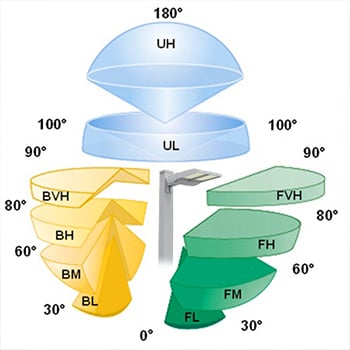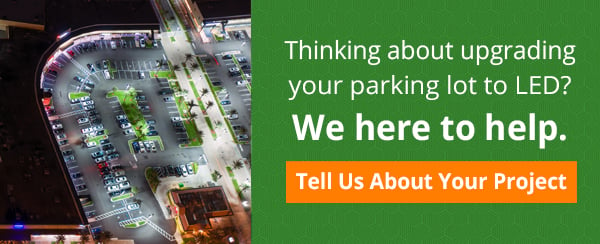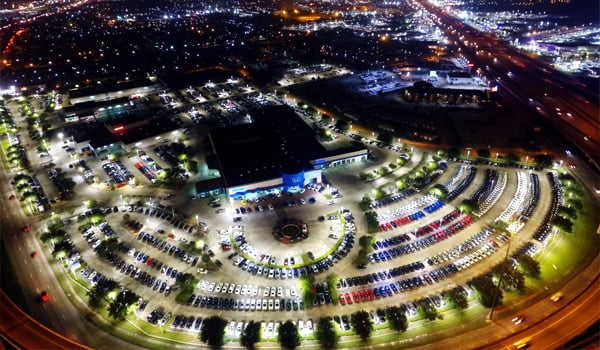
When it comes to lighting up a parking lot at night, it can become expensive if done incorrectly. Property owners need to think about lighting a parking lot with enough coverage to eliminate dark areas, improve visibility, and create an inviting experience for visitors. Poorly lit parking areas can encourage criminal activity and make employees and customers feel unsafe walking around in the evening. If replacing or upgrading your existing parking lot lighting seems like an unreasonable expenditure, weigh the alternative – can you afford not to do it? If your parking lot lighting is not already using LEDs, it most likely utilizes inefficient legacy technology and costs more to run long term. Between the energy cost reduction, the elimination of maintenance, and ultra-long lifetimes, you will find an appropriate ROI that can offset the initial expense of an upgrade. While doing your preliminary research, here are some important questions to consider before you upgrade your parking lot lighting.
1. Which Lighting Technology Is Right For My Property?
High-Intensity Discharge (HID) lamps have an arc that passes between two electrodes in a pressurized tube. This causes various metallic additives to vaporize and release significant light. The electricity first enters through the ballast in the fixture containing the HID lamp. The starter inside the ballast provides the high-voltage jolt of electricity, which ignites the HID bulb. Once the electricity enters the base of the HID lamp, it flows into the sealed glass envelope which contains gas and metallic salts. This gas helps with the strike of light and once the gas is excited, it heats up and vaporizes the metallic salts. After all this, chemical combustion produces artificial light. Continued use of HID increases costs associated with maintenance and nullifies potential energy savings over time. In addition to the increased overhead to run HID, their lifetimes do not normally exceed 20,000 hours and are subject to extreme color shifting over time.
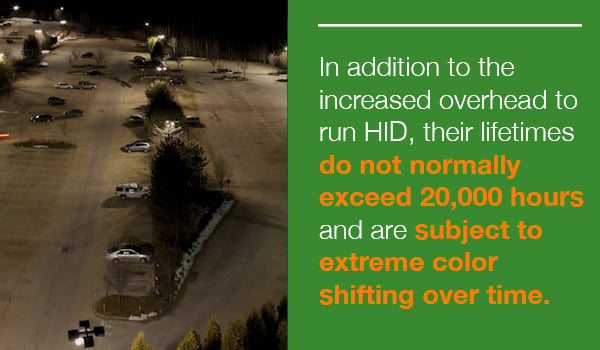
Light-emitting diodes (LED) is a semiconductor light source that emits visible light when a current passes through the material. Electrons in the semiconductor recombine with electron holes, releasing energy in the form of photons. Overall, LED lighting is more efficient, which can be immediately measured. Unlike HID that requires bulky reflectors to direct light, LED luminaires can have molded optics that precisely direct light where it is needed.
In the past, HID has been a primary choice for parking lot installations because of the large amount of light that can be thrown from the fixture for sizable areas and its lower upfront cost. However, because of its inefficiency, it takes an extended amount of time to warm up before full illumination and the quality of light decreases significantly after only 10,000 hours. When you factor in the re-lamping and ballast replacements over the fixture lifetime, long term costs surpass the initial savings on installation. LEDs virtually eliminate all maintenance associated with lighting, and when combined with energy savings, produce a significant ROI that is hard to refute.
2. How Do I Get The Light Where I Need It?
Parking lot layouts are vastly different across the country and have a variable number of poles installed at the time of construction. Traditionally HID threw large pools of light to the ground, albeit inefficiently and often imprecisely. When weighing the option to upgrade to LED lighting, you will have to decide if you will keep the existing poles or replace them completely. With the efficiency that LED lighting brings, you can get more light with fewer luminaires by utilizing optics that distribute it precisely on the ground. After conducting a photometric study and getting a lighting layout, you can make an informed decision to utilize the existing poles or make adjustments to the quantity on-site. Another consideration aside from pole height and the distance between is the actual structural integrity of the poles themselves. In most situations, poles can be utilized for new lighting plans if they match the desired aesthetics you are looking for and it is typically more cost-effective to do such.
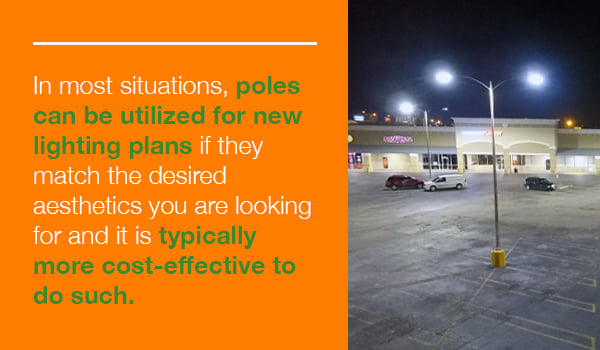
3. What Other Characteristics Make A Parking Lot Look Better?
What attributes make some commercial parking lots look better at night than others? What is their secret? More than likely the LED lighting was properly optimized for the application. In regards to lighting design, standards are determined by the experts at the Illuminating Engineering Society to benefit the public and ensure wellbeing. Lighting manufacturers offer many outdoor solutions for commercial parking lots and below are just a few to contemplate during the planning process.

Correlated Color Temperature (CCT)
The correlated color temperature of an LED luminaire defines the color appearance of the white light. Luminaire CCT is defined in degrees Kelvin, typically ranging from 2700K (Warm Yellowish) to 6,700K (Bluish White Light). Most commercial LED parking lot lighting, especially automotive dealerships, utilize 5000K CCT for optimum effect.

Color Rendering Index (CRI)
The color rendering index is a numerical rating of the ability of a light source to reveal the colors of various objects accurately in comparison to daylight conditions. LED lighting solutions with a high CRI are desirable in color-critical applications like retail stores, healthcare facilities, and car dealership lighting design.
Backlight, Uplight, and Glare (BUG) Ratings
BUG ratings are used to evaluate an LED luminaire’s optical performance concerning light trespass (backlight), light pollution (uplight), and the angle forward light (glare). These ratings are determined by the lumens that fall within certain zones of photometric test data, normally conducted a third-party testing facility. The system was originally developed by the Illuminating Engineering Society and the International Dark-Sky Association to calculate how much light was escaping into undesirable locations.
4. How Will Lighting Controls Benefit My Parking Lot?
The days of commercial properties leaving their lights on 24/7 and sustaining high energy costs are coming to an end now that LEDs have paired with controls. LED lighting luminaires incorporate drivers that can enable continuous dimming, where the shift from 100 to 10 percent is smooth and seamless (not tiered). When paired with passive infrared photo/motion (PIR) sensors, they can detect motion and adjust light output, as necessary. Even after the sensors have stopped detecting motion, adjustable time delay controls can keep lights on at full output for a predetermined amount of time before dimming down to the lowest setting and then off completely. Twist-lock photocontrol or photocell dimming accessories offer adjustable control solutions for outdoor LED luminaires and automatically adjust light levels from dusk to dawn.
Having innovative controls integrated with commercial LED lighting can further increase energy savings, reduce unnecessary light pollution, and provide operational insights. As the Internet of Things (IoT) enables people to connect a wide variety of items via the web, LED lights can be controlled digitally by precise amounts and get real-time reporting of how a building’s systems are performing. According to the U.S. Department of Energy’s Solid-State Lighting Forecast Report, between the years 2015 and 2035, a cumulative energy savings of 62 quads (62 quadrillion BTUs) will be possible if the DOE’s goals for connected lighting and efficient LEDs are realized.
Making The Switch To LED
Since commercial LED lighting efficiencies have matured and controls become robust, now is the time to make the switch to capitalize on the savings. How do you choose the right lighting solutions for your parking lot? How do you know if the cost savings would justify the initial investment? Over the last 18 years, our lighting experts have been trusted to provide LED lighting solutions to over 18,000 installations all over the country. This experience can be used to assist you with your project, providing analysis, and lighting layouts to fulfill your specific requirements. Click below to get started!
Want to learn more about the benefits of LED lighting? Read more about them here. You can also learn more about our Dorado XLE and Dorado XLP LED parking lot lights that are assembled in the USA (Houston, Texas).

